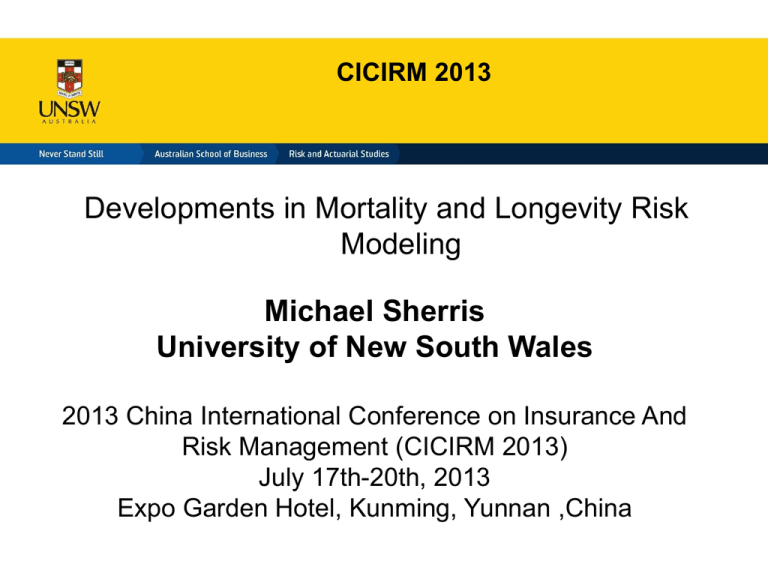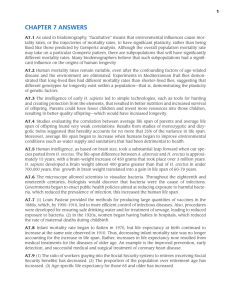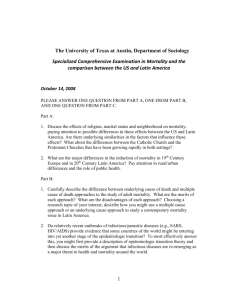report
advertisement

CICIRM 2013 Developments in Mortality and Longevity Risk Modeling Michael Sherris University of New South Wales 2013 China International Conference on Insurance And Risk Management (CICIRM 2013) July 17th-20th, 2013 Expo Garden Hotel, Kunming, Yunnan ,China Longevity/Mortality Models Mortality/Longevity Models Demographic and Actuarial models Life tables Improvement factors Stochastic Financial Risk Survival Curve Framework models models Aged based nonParametric or Parametric survival curve Stochastic parameters Risk factor dynamics Price of risk Consistent Market calibration Longevity/Mortality Models Data Individuals • Risk factors: Age, sex, smoking status, education, occupation, ethnicity, income, geographical location, marital status • Cause of death • Survey data Population by country • Aggregate mortality by age, gender, period, cohort • Aggregate health data • Prevalence of health conditions • Mortality rates by Causes of death Life insurance, pension fund and annuity pools • Aggregation of deaths and exposures by underwriting risk factors • Effect of selection Longevity/Mortality Model Risk Systematic Risk • Uncertain future mortality – age-period-cohort trends, survival curve, risk factors, price of risk Idiosyncratic Risk • Pooling of individual survival risks – pool size, assumption of i.i.d. risks Heterogeneity • Mortality rates and trends varying by individuals of the same age (gender) Agenda – Model Risks - Cohort and forward survival curves (financial risk) versus age-period models (demographic/actuarial/survival curve adapted for cohort effects) - Consistent versus inconsistent mortality curves (dynamics and future survival curves) and parameter stability - Risk factors and price of risk (explicit versus ad-hoc risk adjustment) - Heterogeneity – multiple state models with systematic risk versus heterogeneity only (frailty, Markov ageing models) - Drawing on longevity research at CEPAR, UNSW Some of the issues – which would you prefer? Model A Males Model B Source: Shao, W., Sherris, M., and Hanewald, K., (2103), Reverse Mortgage Pricing and Capital Requirements Allowing for Idiosyncratic House Price Risk and Longevity Risk. Some of the issues – which would you prefer? Model A Females Model B Source: Shao, W., Sherris, M., and Hanewald, K., (2103), Reverse Mortgage Pricing and Capital Requirements Allowing for Idiosyncratic House Price Risk and Longevity Risk. Systematic Mortality Model Risk Model A Model B • Discrete age survival function • Cohort trends – period and age-to-age variability and trends • Cohort curve generated by the dynamics • Multiple risk factors based on age • Dependence in volatility – principal components • Parametric survival function smoothing of age-to-age variability • Period trends • Cohort curve read off projected period curves • Two factors - stochastic parameters of mortality curve • Dependence – two factors, from smoothed curve dynamics Importance of cohort and forward survival curves Source: Alai, D.H. and Sherris, M. (2012), Rethinking Age-Period-Cohort Mortality Trend Models, Article published on line 16 Apr 2012, Scandinavian Actuarial Journal Model Mortality Surface (age-period and cohort) Source: C. Blackburn and M. Sherris, (2013), Consistent Dynamic Affine Mortality Models for Longevity Risk Applications, Insurance: Mathematics and Economics, Volume 53, Issue 1, July 2013, Pages 64–73 Quantification of Systematic Longevity Risk Forward survival curves (cohort) Expected survival curves and pricing Source: C. Blackburn and M. Sherris, (2013), Consistent Dynamic Affine Mortality Models for Longevity Risk Applications, Insurance: Mathematics and Economics, Volume 53, Issue 1, July 2013, Pages 64–73 Consistent survival curves – 3 factor model Three Factor Consistent HJM mortality model Dynamics generates consistent survival curves Source: C. Blackburn and M. Sherris, (2013), Consistent Dynamic Affine Mortality Models for Longevity Risk Applications, Insurance: Mathematics and Economics, Volume 53, Issue 1, July 2013, Pages 64–73 Consistent model risk factors – 3 factor estimation stability Refitting model at different time points demonstrates model consistency How many models used in practice have this property? Source: C. Blackburn and M. Sherris, (2013), Consistent Dynamic Affine Mortality Models for Longevity Risk Applications, Insurance: Mathematics and Economics, Volume 53, Issue 1, July 2013, Pages 64–73 Consistent Survivor Curves – 2 versus 3 factor Increase in number of factors explains older age mortality better Source: C. Blackburn and M. Sherris, (2013), Consistent Dynamic Affine Mortality Models for Longevity Risk Applications, Insurance: Mathematics and Economics, Volume 53, Issue 1, July 2013, Pages 64–73 Best Estimate Forward Survivor Curve – 2 factors Removes need for simulations in simulations for ALM, valuation, risk quantification Price of Risk and Forward Survivor Curve – 2 factors Price of risk – financial approaches versus actuarial (Wang transform) Wang transform gives wrong signs and magnitude for prices of risk (offset by other parameters) Sharpe ratio scales the survivor curve and does not impact risk factor loadings Price of risk - longevity risk swap pricing Pricing differences less pronounced than for risk quantification Price of risk versus volatility parameter risk – survival curve Source: Fung, M. C., Ignatieva, K. and Sherris, M., (2013), Systematic Mortality Risk: An Analysis of Guaranteed Lifetime Withdrawal Benefits in Variable Annuities Price of risk versus volatility parameter risk GLWB Equity exposure Mortality risk premium Source: Fung, M. C., Ignatieva, K. and Sherris, M., (2013), Systematic Mortality Risk: An Analysis of Guaranteed Lifetime Withdrawal Benefits in Variable Annuities Price of risk and impact on risk based capital Solvency capital costs versus longevity swap for a life annuity Varying price of risk in Model A Incentives to hedge shorter terms and retain tail risk with higher prices of risk Source: Meyricke, R. and Sherris, M. (2013), Optimal Longevity Risk Management Under Solvency II Mortality heterogeneity - which model? Calibration to population data versus individual data (GLMM) Frailty versus Markov ageing Does not include systematic mortality risk required to assess solvency/tail risk Source: Ramona Meyricke and Michael Sherris (2013), The determinants of mortality heterogeneity and implications for pricing underwritten annuities. Heterogeneity model risk – longevity tail risk for annuity fund Fixed investment return of 3% p.a. Mortality model Markov Le Bras Vaupel Heterogeneity best health only mixed mixed w self selection best health only mixed mixed w self selection best health only mixed mixed w self selection Annuity premium 16.32 14.29 14.29 15.84 14.16 14.16 16.29 14.72 14.72 Risk measures at age 110 Mean Stdev 95% VaR -0.07 386.09 631.73 -15.86 710.31 1176.89 5872.49 428.07 6566.69 4.24 607.33 986.31 11.56 635.70 1022.46 3105.13 613.12 4109.81 -0.88 658.73 1072.07 -1.61 673.32 1109.78 2610.51 666.36 3694.48 Premium for a life annuity of 1 p.a. and tail risk measures for a pool of 1000 individuals aged 65. Source: Sherris, M. and Zhou, Q. (2013), Model Risk, Mortality Heterogeneity and Implications for Solvency and Tail Risk. Effect of adverse selection Heterogeneity model risk – investment and longevity tail risk for annuity fund Random investment return Mortality model Markov Le Bras Heterogeneity best health only state 2 state 3 state 4 state 5 mixed mixed w self selection best health only mixed mixed w self selection best health only mixed mixed w self selection Annuity premium Risk measures at age 110 13.48 12.54 10.04 6.74 5.00 11.99 Mean Stdev 95% VaR -199.80 4912.11 7843.93 -198.90 4387.30 7117.17 -111.25 3192.87 5144.76 -54.63 1917.96 3131.44 -35.88 1478.46 2441.54 -132.34 4420.42 7051.55 11.99 12.95 11.84 -14675.61 -109.05 -59.61 4112.85 4901.30 4283.44 21204.18 7811.46 6883.19 11.84 13.14 12.13 -7006.90 -141.61 -112.90 4244.59 5040.23 4476.47 13922.83 8067.82 7234.56 Investmen t risk magnifies longevity risk and impact of selection Vaupel Premium for a life annuity of 1 p.a. and tail risk measures for a pool of 1000 individuals12.13 aged-5777.86 65 4397.70 12874.70 Results are shown for the different deterministic models of heterogeneity. Source: Sherris, M. and Zhou, Q. (2013), Model Risk, Mortality Heterogeneity and Implications for Solvency and Tail Risk. Heterogeneity model risk – impact of systematic longevity risk Pool size 100 1000 10000 100000 Deterministic Subordinated Markov Markov 122.66 286.21 388.23 2588.74 1216.31 25649.07 3914.59 254307.38 Without systematic risk $500 $400 $300 $200 $100 $- Standard deviation of the fund at age 110 for life annuity of 1 p.a. for best health individuals aged 65 Fixed investment return of 3% p.a. Stochastic model variance of Gamma time change ν=0.095. 252627282930313233343536373839404142434445 years since start of contract Pool 500 Pool 1000 With systematic risk $3,000 $2,500 $2,000 $1,500 $1,000 $500 $252627282930313233343536373839404142434445 years since start of contract Pool 500 Pool 1000 Source: Sherris, M. and Zhou, Q. (2013), Model Risk, Mortality Heterogeneity and Implications for Solvency and Tail Risk. Summary – key points Mortality/longevity risk model developments – key ideas • • • • Model consistency and parameter stability Tractability and ease of application Risk factors and price of risk Heterogeneity and data 26 Thank you for your attention Michael Sherris m.sherris@unsw.edu.au School of Risk and Actuarial Studies ARC Centre of Excellence in Population Ageing Research University of New South Wales Acknowledgement: ARC Linkage Grant Project LP0883398 Managing Risk with Insurance and Superannuation as Individuals Age with industry partners PwC, APRA and the World Bank as well as the support of the Australian Research Council Centre of Excellence in Population Ageing Research project CE110001029. References Alai, D.H. and Sherris, M. (2012), Rethinking Age-Period-Cohort Mortality Trend Models, Article published on line 16 Apr 2012, Scandinavian Actuarial Journal, DOI: 10.1080/03461238.2012.676563 Su, S. and Sherris, M. (2012), Heterogeneity of Australian Population Mortality and Implications for a Viable Life Annuity Market, Insurance: Mathematics and Economics, 51, 2, 322–332. Ziveyi, J, Blackburn, C., and Sherris, M. (2013), Pricing European Options on Deferred Annuities, Insurance: Mathematics and Economics, Volume 52, Issue 2, March 2013, 300–311. Blackburn, C. and Sherris, M., (2013), Consistent Dynamic Affine Mortality Models for Longevity Risk Applications, Insurance: Mathematics and Economics, Volume 53, Issue 1, July 2013, Pages 64– 73 http://dx.doi.org/10.1016/j.insmatheco.2013.04.007 Meyricke, R. and Sherris, M. (2013), The determinants of mortality heterogeneity and implications for pricing underwritten annuities, accepted Insurance: Mathematics and Economics, on-line 29 June 2013; http://www.sciencedirect.com/science/article/pii/S0167668713000887 Meyricke, R. and Sherris, M. (2013), Optimal Longevity Risk Management Under Solvency II. Sherris, M. and Zhou, Q. (2013), Model Risk, Mortality Heterogeneity and Implications for Solvency and Tail Risk. Fung, M. C., Ignatieva, K. and Sherris, M., (2013), Systematic Mortality Risk: An Analysis of Guaranteed Lifetime Withdrawal Benefits in Variable Annuities. Shao, W., Sherris, M., and Hanewald, K., (2103), Reverse Mortgage Pricing and Capital Requirements Allowing for Idiosyncratic House Price Risk and Longevity Risk.






